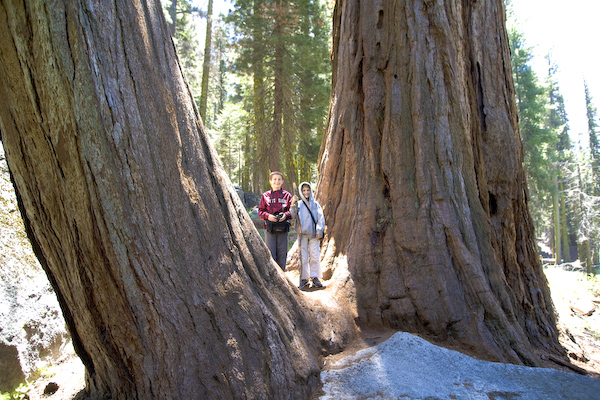A Sense of Scale
Earlier this year, as part of a blog entry entitled, “What is it?”, I posted an image which intentionally lacked clues regarding scale. The effect was quite strong — many viewers had a difficult time recognizing the subject due to the lack of clues regarding scale. This week, we re-examine the issue of scale from a less drastic point of view.
The above image was taken of a pair of trees in Sequoia National Park. Once again, there are few clues regarding scale. The effect isn’t as strong as with the aforementioned blog entry — here, at least, you can recognize that these are trees. However, you don’t know how large these trees are. If you happen to recognize that these are sequoia trees, you might cognitively realize that these could be quite large, but there is little perceptually available to convey their actual size.
So, let’s play a little game: Guess the diameter of the trees.
(a) 8 inches?
(b) 12 inches?
(c) 18 inches?
(d) 2 feet?
(e) 3 feet?
(f) 5 feet?
It’s hard to tell. Everything we’ve learned and experienced about trees gives us a range that we consider normal, and so we expect trees to have diameters in that range. You might have come up with a guess but, after all the attention I’ve drawn to this, you might have bumped-up your guess to the next higher choice. I’ll keep you in suspense just a little longer.
We tend to measure things by comparison with other known things. The rocks and other trees just don’t give us enough clue because their sizes can vary so much. If we were to put a ruler (or yard stick) in front of one of the trees, we would get a better numerical idea of the diameter. If we were to put a person next to the trees, we would get a better qualitative idea of the diameter.
I know the suspense is building. I’ll give the answer shortly.
I’ve mentioned this before, but it’s worth mentioning again. Dewitt Jones, the renowned National Geographic Photographer, once shared a secret to his success in creating images with impact. He would ask himself what feature about a place or scene grabs his attention and then, once he determined that key feature, strove to eliminate all distraction. Sometimes, the key feature is texture, or color, or line, or form; in these cases, the lack of clues regarding scale is not only acceptable but sometimes a particularly effective technique. At other times, though, the key feature is size (in Sequoia National Park, the sheer size of the trees really grabs your attention) and then you really need to put something into the image of known size which enables the viewer to make a relative comparison and comprehend the real (unexpected) size of the feature. Whether or not your image includes clues regarding scale, you should make a conscious decision about it. If size is the key feature, your image will be much more successful if you include such clues; on the other hand, if you want to obscure the size of the features, consider leaving such clues out of the image.
Okay (finally). The following image should help you answer the question regarding the diameters of the trees:
Did you think they could be as large as 10 feet in diameter? The earlier picture failed to convey that. This played out nicely with my youngest sons who were very willing to pose for this shot. The youngest son, upon seeing the first picture and being asked to estimate the diameters, thought they might be about the size of a table; when he saw the second picture, his jaw dropped and he emitted the following utterance: “Whoa! Those are HUGE!”. As an epilog, it turns out that these two sequoias are mere “teenagers”; some sequoias have been found with diameters near 40 feet.
By the way, if you happen to have a computer monitor which (at normal display resolution and horizontal orientation) enables you to see both of the images in this blog simultaneously in the same window (that is, without scrolling), then I’m jealous :-)

Tip of the Week
2007.06.25


